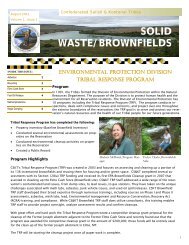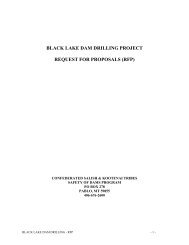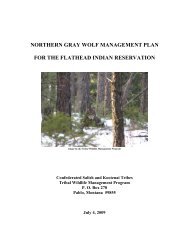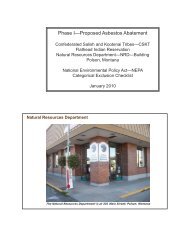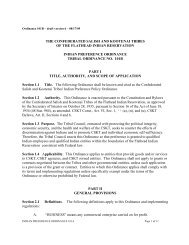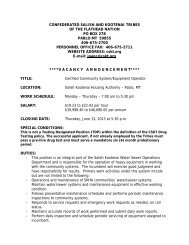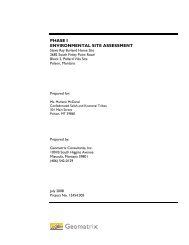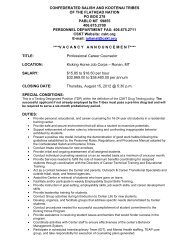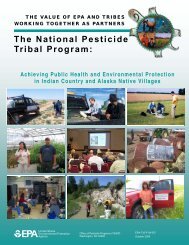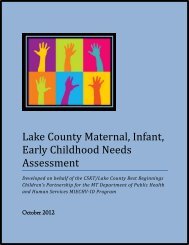2006 annual report - cskt - Confederated Salish and Kootenai Tribes
2006 annual report - cskt - Confederated Salish and Kootenai Tribes
2006 annual report - cskt - Confederated Salish and Kootenai Tribes
You also want an ePaper? Increase the reach of your titles
YUMPU automatically turns print PDFs into web optimized ePapers that Google loves.
<strong>Confederated</strong> <strong>Salish</strong> <strong>and</strong> <strong>Kootenai</strong> <strong>Tribes</strong>’ Annual Repor t <strong>2006</strong><br />
16<br />
The Safety of Dams’ operating budget was<br />
$6.385 million from BIA Compact funds. It<br />
employed 21 FTEs; 19 were CSKT members.<br />
Work included field investigations, engineering<br />
designs, <strong>and</strong> construction activities to reduce<br />
or eliminate deficiencies at Bureau of Indian<br />
Affairs’ dams. The program also monitored<br />
conditions at dams via the National Monitoring<br />
Center <strong>and</strong> informed interested agencies with<br />
data.<br />
The Roads Program’s operating budget<br />
was $2.93 million in BIA Compact funds<br />
<strong>and</strong> employed six FTEs; four were CSKT<br />
members. Maintenance outcomes include<br />
blading, grading <strong>and</strong> snow removal on BIA<br />
Roads. Construction outcomes include the<br />
construction of drainage improvements, paved<br />
streets <strong>and</strong> concrete sidewalks. Planning<br />
outcomes include the update of the road<br />
inventory <strong>and</strong> preparation for a Transportation<br />
Improvement Plan.<br />
DIVISION OF FISH,<br />
WILDLIFE, RECREATION,<br />
AND CONSERVATION<br />
The Division of Fish, Wildlife,<br />
Recreation <strong>and</strong> Conservation<br />
is the largest division of NRD. In fiscal year<br />
<strong>2006</strong>, the division budget was $7.38 million<br />
<strong>and</strong> employed 41 FTEs; 29 were CSKT<br />
members.<br />
The most significant event for fiscal year <strong>2006</strong><br />
was the completion of wetl<strong>and</strong> <strong>and</strong> riparian<br />
l<strong>and</strong> acquisition for Kerr mitigation.<br />
In 1985, when Kerr Dam had to be relicensed<br />
with the Federal Energy Regulatory<br />
Commission, environmental code required that<br />
negative impacts to fish <strong>and</strong> wildlife caused by<br />
the dam’s operation were to be corrected. In<br />
1997, the Federal Energy Regulatory<br />
Commission issued a final order outlining what<br />
mitigation goals had to be reached. CSKT<br />
sought <strong>and</strong> was granted the task of meeting<br />
those goals, which is to acquire l<strong>and</strong> able<br />
to produce 3,089 wetl<strong>and</strong> credits. (Credits<br />
are based on a complex calculation of lost<br />
acres. Each credit is equivalent to 1.5 acres<br />
of wetl<strong>and</strong> or 4 aces of dry l<strong>and</strong>s surrounding<br />
the wetl<strong>and</strong>s that provide nesting habitat<br />
<strong>and</strong> watershed protection.) For the past six<br />
years, staff teamed with L<strong>and</strong>s <strong>and</strong> Legal<br />
departments to acquire these credits using<br />
funds provided by Montana Power Company<br />
<strong>and</strong> PPL Montana.<br />
The tribes were able to use mitigation funding<br />
also to purchase a total of 18,440 acres of<br />
fee l<strong>and</strong> on the Reservation. Now that all<br />
the l<strong>and</strong> has been acquired, the fish <strong>and</strong><br />
wildlife habitats on the mitigation l<strong>and</strong>s will be<br />
restored with funding from a separate habitat<br />
restoration account that was also part of the<br />
mitigation.<br />
DIVISION OF ENVIRONMENTAL<br />
PROTECTION<br />
The Division of Environmental Protection<br />
houses the Indian General Assistance<br />
Program, a Shoreline Protection Office, Air<br />
<strong>and</strong> Water Quality, Non-Point Source pollution<br />
program, Wetl<strong>and</strong>s Conservation, Solid <strong>and</strong><br />
Hazardous Waste, a Brownfield program,<br />
<strong>and</strong> its newest addition this past year, the<br />
Pesticides Program. The Division’s primary<br />
purpose is to monitor, evaluate, <strong>and</strong> regulate<br />
activities on the reservation that may impact<br />
environmental quality.<br />
The Shoreline Protection Office processed<br />
157 shoreline permits <strong>and</strong> 57 aquatic<br />
l<strong>and</strong>s permits, <strong>and</strong> collected approximately<br />
$121,000 in dock fees <strong>and</strong> permits. During<br />
the past year, three Phase II Environmental<br />
Site Assessments were completed for three<br />
primary Brownfield sites: Elmo Cash Store,<br />
former Char-Koosta News building, <strong>and</strong><br />
the old St. Ignatius/Woodcock dump. The<br />
fiscal year <strong>2006</strong> operating budget totaled<br />
approximately $820,000 <strong>and</strong> employed 17<br />
FTEs; 15 were CSKT members.



